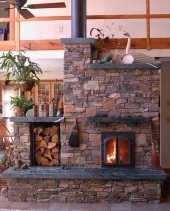Hello folks. I just tonight found this site.I was looking for info on subfloor wood head for greenhouses.I won't go into the construction now,but i'd like to describe my home heating device. I have been using a version of it for almost 20 years.I put a water heating contraption in it around 95. It is heating my house now, and I have about 45 gals of hot water in a 60 gal tank beside me.The temp of that water is 145 at the top and 90 at the lower level.
It's core is a double barrel Sotz kit barrel stove. I like their door best. I "wrap"the stove with a plenum cut from a discarded 275 gal fuel tank. One end is left on and becomes the top of the air plenum. The front is cut out for door access, and to get it around the barrels. 55 gal barrels don't fit completely in without notching the plenum. I put a smoke deflector piece at the top of the bottom barrel and the cut out. Helps keep smoke out of the heated air. on top are holes for hot air to get out, and the stovepipe to get to the top barrel.These can be any size you want, mine are 6 inch and 12 inches. From these salvaged 12 inch air pipe rises to my floor grates, with the 6 inch going to the bathroom and the porch if wanted.It's 80 in here now, 2 story 27x36.
I use a 60 gal tank made by whitehead in 1939 from copper. It needs replacing and probably I'll have to use a semi truck fuel tank with the proper threaded holes welded in. It's upstairs, the stove is down cellar. This is plenty of rise for the convection of air and water. Water comes down from the tank to a tempering valve,[1/2 ball sweat] then down to the lower edge of the bottom barrel, then is split so as to get to both sides fo the barrel, then through copper 1/2 pipes 12 inches long held to the barrels ridges by a big home made hose clamp. 7 pipes on each side joined at the top and back up to the tank. 90 degree elbows with very short pieces in them keeps the exchanger short. I soldered them up with some upward angle on them and they work great. One thing I did not do that should be done, is fit t&p valves before and after the water going to and exiting the stove.Somthing about steam might blow it apart. I got lucky my rig has no traps that happens in.
This rig is repairable, doesn't need much care and was affordable. Scrubbing out the stove pipe and ash removal is it. How much? Everything was scrounged but the copper pipe stuff. I am a so so steel fabricator with the tools,and it took 5-6 days. So it is nor for everyone. I came here to pick up a few bones and I like to throw a few down if I can.I will give more details and such if anyone wants, see ya later. Bert.



